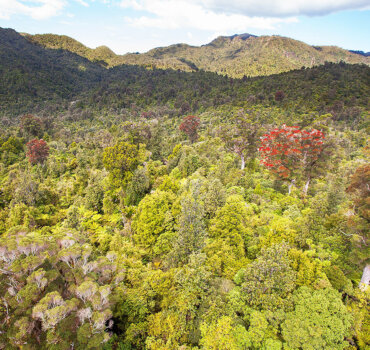
Two views – the Papakai block with dead rātā contrasts sharply with the read flowering trees which have flourished under a regime of pest control. Photos – Department of Conservation.
Drone images of two sections of the Papakai Block in the Coromandel forest released by the Department of Conservation this week have illustrated the enduring benefits of waging war on introduced pests.

Two views – the Papakai block with dead rātā contrasts sharply with the read flowering trees which have flourished under a regime of pest control. Photos – Department of Conservation.
 Its media release didn’t mention 1080 – but the controversial poison was the major factor in restoring forest habitat over a quarter of a century in part of the Coromandel Forest.
Its media release didn’t mention 1080 – but the controversial poison was the major factor in restoring forest habitat over a quarter of a century in part of the Coromandel Forest.
The Department of Conservation’s (Doc) aerial shots show on one hand the impact of possums on a section of ancient forest in northern Coromandel – and on the other, what happens when possums are controlled.
The poison 1080 has been part of the war on New Zealand pests for more than 50 years – and despite opposition to its use, reports continue to conclude the benefits outweigh the risks.
The images on this page were obtained as part of work by Doc staff from the Coromandel district, when they carried out seed collection tasks in summer as part of efforts to stop the spread of the tree disease myrtle rust and safeguard genetic seed stock for the species.
Myrtle rust has the potential to weaken and eventually kill species such as pōhutukawa, manuka and rātā.
The drone images show sections of forest canopy in the Papakai block of the Coromandel Forest Park, which straddles the spine of the Coromandel range.
Nick Kelly, Doc’s Coromandel Operations Manager, says the images show the stark contrast between an area where there has been more than 25 years of predator control effort, and an adjacent section of land where predator control has been undertaken twice in the last decade.
“The tops of the rātā trees in the two images are where the difference is really evident,” he says.
“In the area where we’ve had long-term predator control, you can see the distinctive red-brown colour of the rātā trees flowering — they’re good healthy trees, with plenty of leaf coverage and no signs of the damage possums cause.
“But in the other image, several dead rātā are clearly visible — over time, they’ve been stripped of leaves by possums and that’s led to the trees dying.
“Those dead specimens really stick out, and they’re a trigger for what we term a ‘top-down collapse’ of the forest eco-system.”
When larger trees die off due to the impact of possums, wider biodiversity and forest health is compromised – at the expense of native flora and fauna.
Nick Kelly says the damage done by possums isn’t always visible to visitors enjoying the forest.
“You can wander through the forest and not necessarily see the impact of these introduced pests. What the drone imagery shows us is what people do not see when they’re out for a walk or a tramp.”
Doc’s predator control efforts are essential to protect New Zealand’s native species, as introduced pests like possums, stoats and rats eat native plants, insects, birds and eggs.
The Coromandel forest being protected is home to important native species such as Archey’s frogs, Coromandel striped gecko and Coromandel brown kiwi.
It’s also believed the area has woodrose/pua o te reinga (Dactylanthus taylorii), an extremely rare and threatened parasitic, fungi-like plant which is pollinated by long-tailed bats (pekapeka) but destroyed by rats and possums.
Doc is consulting with iwi, landowners and stakeholders for a Tiakina Ngā Manu predator control operation recommended for later this year.








